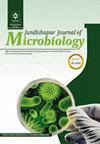Assessment of Salivary Glands as Reservoirs of SARS-CoV-2 and the Contagiousness of Saliva in Asymptomatic COVID-19 Patients: Is Delta Variant More Contagious?
IF 0.5
4区 医学
Q4 MICROBIOLOGY
引用次数: 0
Abstract
Background: Severe acute respiratory syndrome coronavirus 2 (SARS-CoV-2) infection transmits when aerosols or droplets containing the virus are inhaled or come directly into contact, mainly in close contact with an infected person. Objectives: This study aimed to evaluate the role of the salivary glands in the secretion of SARS-CoV-2-infected saliva and determine the contagiousness of saliva in asymptomatic coronavirus disease 2019 (COVID-19) patients. Methods: In this cross-sectional analytical study between March 2021 and March 2022, 85 asymptomatic COVID-19 individuals with positive nasopharyngeal/oropharyngeal swabs were recruited. The SARS-CoV-2 cycle threshold (Ct) value was investigated in concomitant nasopharyngeal swabs (NPS), saliva, and pure saliva (collected directly from the salivary duct opening) using Real Time-PCR assay. Statistical analysis was performed using SPSS software (version 23), and a p-value of < 0.05 was considered significant. Results: The saliva Ct-value was the lowest (the highest viral load) for Delta (29.82 ± 4.66), Omicron (32.75 ± 4.82), and Alpha (36.83 ± 4.8) variants, respectively. Delta-infected saliva and pure saliva revealed the strongest correlation (correlation coefficient = 0.971, P < 0.001). Saliva Ct-value was significantly lower in Delta- (P < 0.001) and Omicron- (P = 0.012) infected patients than in Alpha-infected patients. The pure saliva Ct-value was significantly lower (P = 0.014) in Delta samples (30.13 ± 4.51). Asymptomatic Alpha- and Omicron-infected patients revealed significantly lower NPS Ct-value (30.52 ± 4.02 and 29.44 ± 3.34) than the saliva (36.83 ± 4.8 and 32.75 ± 4.82). Conclusions: The major salivary glands secrete SARS-CoV-2-infected saliva in nearly all Delta-infected and most Omicron-infected asymptomatic individuals. Although the transmission process is complex, saliva droplets and aerosols seem to have a higher contagiousness potential in individuals infected with the Delta variant.无症状COVID-19患者唾液腺作为SARS-CoV-2储存库和唾液传染性的评估:Delta变体更具传染性吗?
背景:严重急性呼吸综合征冠状病毒2 (SARS-CoV-2)感染通过吸入含有该病毒的气溶胶或飞沫或直接接触(主要是与感染者密切接触)传播。目的:本研究旨在评估无症状冠状病毒病2019 (COVID-19)患者唾液腺在感染sars - cov -2的唾液分泌中的作用,并确定唾液的传染性。方法:在2021年3月至2022年3月的横断面分析研究中,招募了85例无症状的COVID-19鼻咽/口咽拭子阳性个体。采用Real - Time-PCR检测同时使用鼻咽拭子(NPS)、唾液和纯唾液(直接从唾液管开口采集)的SARS-CoV-2周期阈值(Ct)。采用SPSS软件(version 23)进行统计分析,p值为<0.05为显著性。结果:δ型(29.82±4.66)、Omicron型(32.75±4.82)和α型(36.83±4.8)的唾液ct值最低(病毒载量最高)。δ感染唾液与纯唾液相关性最强(相关系数= 0.971,P <0.001)。唾液ct值显著低于Delta- (P <0.001)和Omicron- (P = 0.012)感染患者比α -感染患者多。Delta样品的纯唾液ct值(30.13±4.51)显著低于前者(P = 0.014)。无症状Alpha-和omicron -感染患者NPS ct值(30.52±4.02和29.44±3.34)明显低于唾液(36.83±4.8和32.75±4.82)。结论:几乎所有delta感染者和大多数omicron感染者的主要唾液腺分泌sars - cov -2感染的唾液。虽然传播过程复杂,但唾液滴和气溶胶似乎在感染Delta变体的个体中具有更高的传染潜力。
本文章由计算机程序翻译,如有差异,请以英文原文为准。
求助全文
约1分钟内获得全文
求助全文
来源期刊

Jundishapur Journal of Microbiology
MICROBIOLOGY-
CiteScore
1.30
自引率
0.00%
发文量
56
审稿时长
6-12 weeks
期刊介绍:
Jundishapur Journal of Microbiology, (JJM) is the official scientific Monthly publication of Ahvaz Jundishapur University of Medical Sciences. JJM is dedicated to the publication of manuscripts on topics concerning all aspects of microbiology. The topics include medical, veterinary and environmental microbiology, molecular investigations and infectious diseases. Aspects of immunology and epidemiology of infectious diseases are also considered.
 求助内容:
求助内容: 应助结果提醒方式:
应助结果提醒方式:


